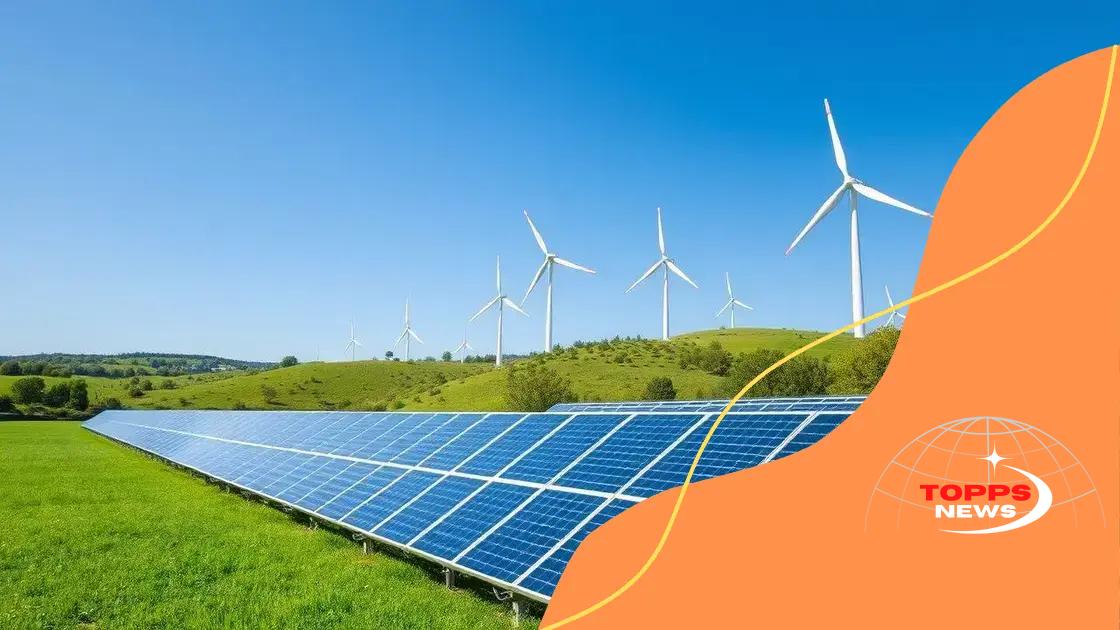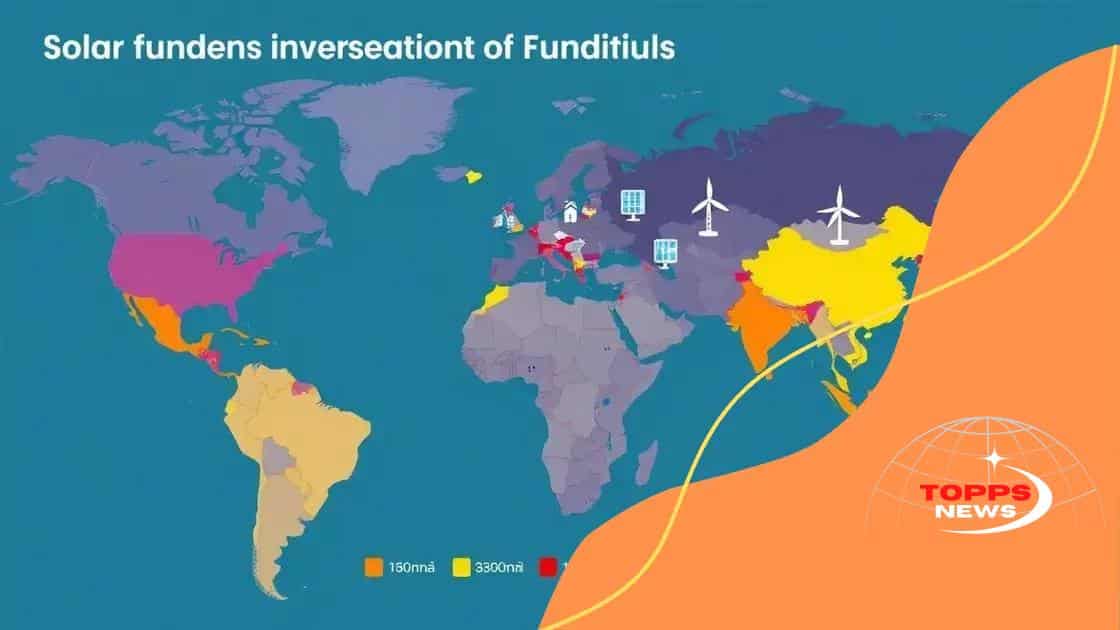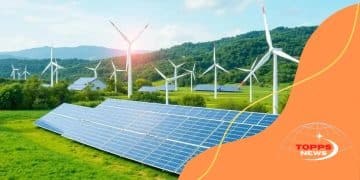Renewable energy investment trends shaping our future

Challenges in renewable energy financing include high upfront costs, regulatory uncertainty, and limited capital access, which hinder investment despite the growing demand for sustainable energy solutions.
Renewable energy investment trends are changing the landscape of how we think about energy sources. With growing concerns about climate change, many investors are looking closely at sustainable options. How are these trends reshaping our future?
Current global investment patterns in renewable energy
Current global investment patterns in renewable energy are evolving rapidly. Many countries are recognizing the need to transition to more sustainable energy sources. This shift is being driven by both economic incentives and environmental concerns.
Trends in renewable energy investments
Investments in renewable energy have shown an upward trend worldwide. The focus is primarily on technologies that harness wind, solar, and hydroelectric power. Countries like the United States, China, and Germany are leading the way, pouring billions into renewable projects.
- In 2022, global renewable energy investment reached a record $500 billion.
- Solar energy attracted the most funds, reflecting its growing affordability.
- Wind energy investments also increased, especially in offshore wind farms.
This growth is indicative of a larger shift in how energy is produced and consumed. Governments are also implementing policies to encourage further investment. For example, tax incentives and subsidies for green energy projects are becoming more common.
The role of technology
Technological advancements play a critical role in the renewable energy sector. Innovations such as energy storage solutions and smart grid technologies are further enhancing investment appeal. Investors are now more confident that these technologies can drive down costs and improve efficiency.
Moreover, the decreasing cost of renewable technologies has made them competitive with fossil fuels. This means that not only do renewable sources contribute to a healthier planet, but they are also becoming financially viable for investors.
As we look to the future, understanding current global investment patterns will be vital for predicting how the energy landscape will continue to evolve. The next few years will be crucial as countries strive to meet their climate goals while fostering economic growth.
Impact of government policies on renewable energy investment
The impact of government policies on renewable energy investment is significant and far-reaching. Effective policies can encourage growth in the renewable energy sector, while ineffective ones can hinder progress. Many governments worldwide are increasing their focus on green energy initiatives to meet climate goals.
Types of government policies
There are several types of policies that can influence investments. Subsidies for renewable energy projects are among the most effective tools. These financial incentives can make it more attractive for businesses and individuals to invest in renewable technologies.
- Subsidies help lower the cost of installation and operation.
- Tax credits encourage companies to shift towards renewable sources.
- Feed-in tariffs guarantee payment for energy generated from renewable sources.
Additionally, government regulations play a crucial role. Stricter emissions standards often push companies to adopt cleaner energy solutions. This regulatory shift creates both opportunities and challenges for investors in the renewable sector.
Long-term effects on investment
Long-term, well-structured policies can lead to a stable investment environment. Clear regulations provide certainty that is essential for attracting capital. Investors are more likely to commit funds when they understand how policies will evolve. Conversely, unclear policies or frequent changes can deter investment.
International agreements also shape national policies. For example, commitments to the Paris Agreement have led many countries to ramp up their focus on renewables. This agreement is pushing governments to prioritize sustainable energy sources, which in turn attracts investment.
As we can see, an understanding of the impact of government policies is vital for anyone looking to invest in renewable energy. Effective policies not only stimulate growth but also foster innovation and technology advancement in the sector.
Regional differences in renewable energy funding

When discussing regional differences in renewable energy funding, it becomes clear that investments vary widely across the globe. Several factors, including economic conditions, government initiatives, and resource availability, contribute to how funding is distributed. These differences can significantly impact the growth of renewable energy sources in each region.
Investment levels by region
Various regions are competing for leadership in renewable energy. For instance, Europe has a strong commitment to sustainable energy. Countries like Germany and Denmark lead with high investment levels in wind and solar technologies. In contrast, parts of Asia, especially China, are pouring vast amounts into solar technology, making it a global powerhouse.
- In 2021, Europe invested over $200 billion in renewable energy.
- China’s investments in solar energy surpassed $100 billion.
- North America is increasing investments, particularly in wind energy.
Although investment levels are rising globally, the focus areas differ significantly. While some regions prioritize one technology over another, others adopt a mixed approach considering their unique geographical strengths.
Challenges and opportunities
Understanding these regional differences can help stakeholders navigate investment opportunities. Regions with less funding may have untapped potential that can be explored. For example, Africa has abundant solar resources but receives relatively low investment compared to its potential. Targeted policies could unlock this potential and attract the necessary capital.
Simultaneously, more established markets can face challenges in scaling up. For instance, while European countries are deeply invested in renewables, regulatory hurdles can slow down new projects. Balancing policy frameworks will be essential for maintaining growth across different regions.
As investments in renewable energy continue to evolve, keeping an eye on these regional trends will be crucial. They will not only highlight growth opportunities but also illustrate how different areas prioritize sustainable energy.
Future technologies driving renewable energy investments
The landscape of renewable energy is rapidly evolving due to future technologies that are driving investments in this sector. Innovations are emerging at a pace that reshapes how energy is produced and consumed globally. Understanding these advancements can help investors and policymakers make informed decisions.
Emerging technologies in energy generation
New technologies are changing the game for renewable energy generation. Solar panels are becoming more efficient at converting sunlight into energy. Similarly, advancements in wind turbine design have increased their energy output, making wind farms more economically viable.
- Perovskite solar cells promise higher efficiency at lower costs.
- Floating wind farms can be installed in deeper waters, tapping into stronger winds.
- Advanced geothermal systems expand the potential for clean energy production.
These innovations open up new avenues for attracting investment, as they offer both technological improvements and cost reductions. More investors are likely to allocate funds to projects featuring cutting-edge technology.
Energy storage solutions
Energy storage is crucial for managing demand and supply in renewable energy systems. Breakthroughs in battery technology have led to significant improvements in storage capacity and longevity. This allows renewable sources like solar and wind power to be stored for use when demand is high.
Technologies such as lithium-ion batteries are now more affordable and accessible, enabling wider implementation in homes and businesses. Additionally, new innovations like solid-state batteries and flow batteries are on the horizon, promising even greater advancements in energy storage stability and performance.
As we look to the future, the integration of smart grid technologies will enhance energy efficiency. These grids allow real-time data monitoring and management, helping to optimize energy distribution and reduce waste. Combined with advancements in artificial intelligence, smart grids will further drive investment in the renewable energy sector.
Outlook shows that as these technologies mature, they will attract greater investment, fostering a sustainable energy future.
Challenges in renewable energy financing
Challenges in renewable energy financing are essential to understand for anyone interested in the growth of this sector. Despite the numerous advantages of renewable energy, securing financing can often be complicated. Investors and project developers face various hurdles that can delay or even halt projects aimed at harnessing clean energy.
High upfront costs
One of the primary challenges is the high upfront costs associated with renewable energy projects. Technologies like solar panels and wind turbines require substantial initial investments. While these projects can offer long-term savings and revenues, the immediate financial burden often discourages potential investors.
- Many renewable energy projects take years to become profitable.
- Transitioning to more efficient technologies can be expensive.
- Funding gaps can arise during the construction phase.
These costs can be a barrier, especially in developing countries, where access to capital markets is limited. In such cases, innovative financing solutions are necessary to encourage investment.
Regulatory uncertainties
Another significant challenge is regulatory uncertainty. Changes in government policies can impact financing decisions, causing hesitation among investors. If regulations are inconsistent or frequently changed, it creates a risky environment for financing renewable energy projects.
Furthermore, administrative delays in securing permits can lead to unforeseen costs and timeline extensions. Investors often look for stability and clear guidelines to avoid possible future losses.
Financial institutions may hesitate to provide loans when they perceive high risks, which leads to a decrease in available funding for renewable projects. These challenges can slow down the deployment of essential clean energy solutions.
It is important to collaborate on innovative financing models to overcome these challenges, such as public-private partnerships or green bonds. By addressing these issues, stakeholders can create a more favorable environment for investment in renewable energy.
In conclusion, addressing the challenges in renewable energy financing is crucial for accelerating the shift toward sustainable energy sources. By understanding the factors that hinder investment and exploring innovative financing solutions, we can foster a more supportive environment for renewable projects. As technology continues to advance and policy frameworks evolve, the future of renewable energy investment holds great promise. Collaboration among stakeholders will be key to overcoming barriers and unlocking the full potential of clean energy.
\n
\n
FAQ – Frequently Asked Questions about Renewable Energy Financing
What are the main challenges in renewable energy financing?
The main challenges include high upfront costs, regulatory uncertainty, and limited access to capital in some regions.
How can innovative financing solutions help overcome these challenges?
Innovative financing, like public-private partnerships and green bonds, can provide necessary funds and minimize risks for investors.
Why is collaboration important in renewable energy investment?
Collaboration among stakeholders can create a supportive environment that fosters investment and accelerates the transition to clean energy.
What role does technology play in renewable energy financing?
Advancements in technology, such as energy storage and efficiency improvements, attract more investments by reducing costs and increasing reliability.





